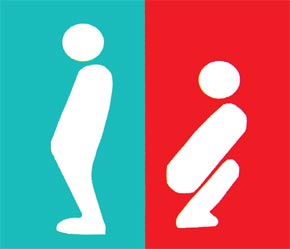 A mild warning – this is a sensitive subject which may offend some of my more gentle readers. Nevertheless, it is a topic that needs to be addressed by all faithful travelers. I bravely march ahead into this uncharted territory, hoping you will forgive me.
A mild warning – this is a sensitive subject which may offend some of my more gentle readers. Nevertheless, it is a topic that needs to be addressed by all faithful travelers. I bravely march ahead into this uncharted territory, hoping you will forgive me.
There are certain physiological activities we all have in common – traits shared by every living creature. Periodically we parade to the nearest comfort station, water closet, loo, or commode. (The names may vary around the world.) But they all describe the same common need – we are responding to nature’s urgent message. What greets us varies a great deal, depending on where in the world we happen to be when this necessity finds us. While a large number of these so-called rest stops are similar to the ones we have become used to in our homes, others greet us with an entirely new, and often confusing set of plumbing devices. It is these unusual visits that I’ve encountered which are the basis for the descriptions that follow.
It was very early in my travels when I was introduced to what the Romanians call the “Turkish Toilet,” and the Turkish people call the “Romanian Toilet.” These less-than-descriptive terms could easily have any other countries’ names substituted in their title. Basically they consist of a hole in the floor which may be ten to 12 inches in diameter. Although the first time one encounters one of these it appears to be about half that size. On either side of this bottomless chasm are two footprints. The latter items are placed here to improve the aim of those less accustomed to this method. For many westerners the unfamiliar squat that is required needs all the assistance it can get for a miss is a disaster, and heaven help us if we tip over. Invariably there seems to be an unusual amount of moisture about the target. Keeping your pants or skirt off the surface requires a certain degree of dexterity. Needless to say, this rest stop is not one of my favorites. A number of years ago I rode a train in Russia which used this method. The jostling motion and the view of the track through the opening remains one of my most feared nightmares.
Another unsettling scene is the one I refer to as the “lack-of-modesty” comfort station. I have run into this category in Africa, Central America, and Nepal – and even on the streets of Paris. Regardless of this wide geographical expanse, they can still be grouped into a single category. In some of these locations they can quickly be dismissed by merely saying “go behind that tree.” In other areas you find yourself precariously balanced on a narrow board or tree branch, protected by a leafy screen with your head higher than the top, therefore able to see all the people watching you. Admittedly you are screened from the shoulders to the knees, but not only is the head open for full viewing, but so is anything that drops to your ankles. Regardless of the constant personal reminder that this activity is universal, it still remains an immodest act for me. Before I leave this category completely, I need to mention those practically-private public stalls sprinkled in some downtown areas of Europe. I wish they extended some two feet higher and went all the way to the ground. I just don’t know where to look when I use one of these places. If you look about and catch someone’s eye looking at you – well, it’s awkward. Looking down doesn’t seem right either. I just don’t know. In Central America I came upon one of these stalls over a river. No secrets were hidden here.
Even when the plumbing is close to matching the ones in my house, I am often confronted with a dilemma. For example, where is the flusher? Some older models have large water collectors mounted on the wall five or six feet above the porcelain receptacle. This system is usually activated by a pull chain with a nice wooden handle. It is often best to stand well back when activating this device because the water comes down in a huge rush, often splashing the surroundings with moisture. Even when the water tank is located in a position you are used to, it can cause a problem. Occasionally the valve refuses to close, and a persistent trickle continues on and on. This forces you to remove the cover and make an adjustment before the flush can be repeated – not a pleasant task. I also dislike those that imply an automatic flush – i.e., no handle. They mostly don’t work.
Probably the one I had the most difficulty mastering was the one I found in several South American countries. I will use the Galapagos Islands as the example. To begin with, the “throne” in most cases is very traditional looking. It is the sign above it and the container next to it which elevate it to be part of this article. To paraphrase this sign, usually in Spanish first, but English is close behind, it reads “Do not put paper in the toilet. Use the waste basket.” I have several possible comments here, but prudence suggests I move on and let your imaginations fill in the details.
I assume by this time you’ve lost interest so I will close – saving some of the more bizarre experiences for later stories.
Leave a Reply